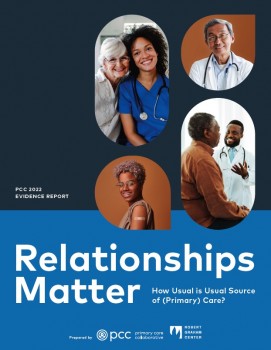You are looking at an archived version of our site. Please visit thepcc.org for a fresh, new experience!
You are here: Array » PCC’s New 2022 Evide ...
PCC’s New 2022 Evidence Report Analyzes Trends In Patient Access to Usual Source of Care (USC)
For Media Inquiries: Edward Walrod, Senior Communications Manager, PCC, ewalrod@thepcc.org
November 16, 2022 (Washington, D.C.)- Today, the Primary Care Collaborative (PCC) and the AAFP Robert Graham Center released PCC’s 2022 Evidence Report, Relationships Matter. How Usual is Usual Source of (Primary) Care?
More Americans lack a consistent source of health care – most often primary care – despite the pandemic, which does not bode well for Americans’ future overall health. Persistent differences between racial/ethnic groups in usual source of care (USC) are likely contributors to ongoing health disparities, made worse by the COVID-19 pandemic.
This comprehensive report puts USC data from 2000-2020 in context and examines trends by age, demographic group, insurance product, and geography. The USC metric matters because a usual source of care is associated with better population health, more equity, and lower costs.
“Americans with an ongoing primary care relationship dropped 10% between 2000-2019, from 84% to 74%, and ticked up only slightly in 2020,” said Ann Greiner, President and CEO of the PCC. “Many innovators are moving into the primary care space because they understand patients are finding it difficult to find affordable primary care. These innovators differ in whether they are supporting longer-term relationships or providing a more transactional set of primary care services.”
The Report by the Numbers:
- Hispanic individuals had a 66% higher rate of no USC (34.3%) as compared to their White counterparts (20.7%) in 2019
- Non-Hispanic Black individuals had a 38% higher rate of no USC (28.4%) as compared to their White counterparts (20.7%) in 2019
- There was a 10% decline in USC for those with dual coverage (Medicare & Medicaid) between 2015 – 2020
- 46% of 18–34-year-olds had no USC in 2019, up from 34% in 2014
- In 2020, there was a spread of 27% points in USC across 50 state
“There are structural barriers preventing our children, families, and neighbors from accessing ongoing preventive and comprehensive care when they need it,” noted Mark Del Monte, JD, chair of the PCC board of directors and CEO/Executive Vice President of the American Academy of Pediatrics (AAP). “There are opportunities for leaders across government and the private sector to partner with primary care and make investments that will improve physical and mental health and well-being.”
Financial barriers, as the report noted, are an ongoing issue for patients and can interfere with getting regular primary care that helps avoid emergency department visits and addresses health problems early before they worsen.
Asaf Bitton, MD Executive Director, Ariadne Labs - Harvard T.H. Chan School of Public Health noted, “Employers have a very important role to play to ensure that all their employees and their families have ready, convenient access to a usual source of affordable primary care. We applaud those employers who are providing highly accessible virtual and in-person primary care options, and working with preferred provider organizations and health systems to support patients in establishing and maintaining these crucial primary care relationships.”
The PCC Report also highlights the need to attract more diverse students to the primary care workforce so that it better reflects the populations they serve.
“We need to train primary care clinicians in teams in community settings where people ‘work and live’ as recommended by the 2021 National Academies of Sciences, Engineering, and Medicine (NASEM) report, Implementing High-Quality Primary Care,” said Yalda Jabbarpour, MD, Director of the AAFP Robert Graham Center for Policy Studies. “The evidence suggests that residents who train in rural and underserved settings, such as Community Health Centers, are much more likely to end up practicing in such settings. This strategy can help address primary care maldistribution and close USC gaps.”
# # #
About the PCC
Founded in 2006, the Primary Care Collaborative (PCC) is a not-for-profit multi-stakeholder membership organization dedicated to advancing an effective and efficient health system built on a strong foundation of primary care and the patient-centered medical home. Representing a broad group of public and private organizations, PCC’s mission is to unify and engage diverse stakeholders in promoting policies and sharing best practices that support growth of high-performing primary care and achieve the “Quadruple Aim:” better care, better health, lower costs, and greater joy for clinicians and staff in delivery of care. For more information about PCC, visit www.pcpcc.org.
About the AAFP Robert Graham Center
The AAFP Robert Graham Center aims to improve individual and population healthcare delivery through the generation or synthesis of evidence that brings a family medicine and primary care perspective to health policy deliberations from the local to international levels.

Recent News
Agosto 16, 2024
Agosto 12, 2024
Luglio 16, 2024
Giugno 24, 2024
May webinar highlights: “The Commercial Market: Alternative Payment Models for Primary Care” Nate Murray explains w… https://t.co/KX9Wi2w6oY —
2 anni 5 mesi fa
@CMSinnovates’ primary care strategy is rooted in a 2021 @theNASEM’s report which called #primarycare “foundational… https://t.co/glbPxvCysg —
2 anni 5 mesi fa
@CMSinnovates has a new #primarycare strategy, envisioning “ACO-based primary care model tests that may focus on pr… https://t.co/aJGF1z411l —
2 anni 5 mesi fa
- Page 1
- ››
Menu secondario
Copyright © 2024 Primary Care Collaborative




